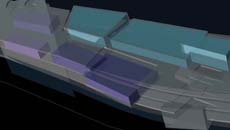North of Ontario School of Architecture
by Anne Cormier, published 2010-03-01

The proposed school of architecture that has been emerging for some years at Laurentian University is guided by the intuition of the possible impacts that such a school would have in Sudbury, more conveniently referred to as North of Ontario. The expected impact for Sudbury would certainly be the cultural contribution of the school by its activities as well as the possible links with local industries. In fact, a possible urban renewal could be provoked by its location in the heart of city, as it was clear to the promoters from the very beginning of the project, that the place for an architecture school is in the city, rather than on the Laurentian campus.
The international competition of open ideas that was held, sought multiple objectives. The idea was to evoke, not only the Sudbury citizens, but the architectural community at large, an interest for the project and its urban impact. If the characteristics of the city were widely exhibited in the program, it was up to the competitors to situate the school within the city, in the perspective of a broad exploration of possibilities and the recognition of the development potential offered by downtown Sudbury. It was also meant to address the ambitious project of a bilingual school, located on the rocky outcrops of the Canadian shield in the middle of the boreal forest in a relatively isolated town in northern Ontario. The NOSOA (Northern Ontario School of Architecture) competition, or, in French, l'ÉANO (École d'architecture du Nord de l'Ontario) was intended to answer the enticing question: "What could a school of architecture be?" In addition, there was a call for the contribution of indigenous communities in the activities of the School. There was speculation that they would support the promotion of sustainable lifestyles and innovation in the forestry sector and entrepreneurship in general.
This ambitious competition with a vast program was fruitful. The 59 proposals received from nine countries on three continents had exceeded the expectations of the organizers and the citizens of Sudbury who are, in some way, the real winners of this competition. The wealth of ideas presented and the range of projects allowed them to appreciate a wide range of urban, landscape and architectural strategies from the consolidation of the urban fabric to the gentle infiltration of downtown where the most interesting proposals sought to repair the disrupted urban fabric through landscaped and built interventions. It's now up to the Laurentian and Sudbury to move forward!
(translated by Carmela Cucuzzella)
The international competition of open ideas that was held, sought multiple objectives. The idea was to evoke, not only the Sudbury citizens, but the architectural community at large, an interest for the project and its urban impact. If the characteristics of the city were widely exhibited in the program, it was up to the competitors to situate the school within the city, in the perspective of a broad exploration of possibilities and the recognition of the development potential offered by downtown Sudbury. It was also meant to address the ambitious project of a bilingual school, located on the rocky outcrops of the Canadian shield in the middle of the boreal forest in a relatively isolated town in northern Ontario. The NOSOA (Northern Ontario School of Architecture) competition, or, in French, l'ÉANO (École d'architecture du Nord de l'Ontario) was intended to answer the enticing question: "What could a school of architecture be?" In addition, there was a call for the contribution of indigenous communities in the activities of the School. There was speculation that they would support the promotion of sustainable lifestyles and innovation in the forestry sector and entrepreneurship in general.
This ambitious competition with a vast program was fruitful. The 59 proposals received from nine countries on three continents had exceeded the expectations of the organizers and the citizens of Sudbury who are, in some way, the real winners of this competition. The wealth of ideas presented and the range of projects allowed them to appreciate a wide range of urban, landscape and architectural strategies from the consolidation of the urban fabric to the gentle infiltration of downtown where the most interesting proposals sought to repair the disrupted urban fabric through landscaped and built interventions. It's now up to the Laurentian and Sudbury to move forward!
(translated by Carmela Cucuzzella)














